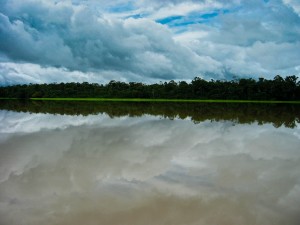18 December 2015
A natural experiment: City in pristine Amazon shows pollution alters ecosystem
Posted by lhwang
by Natalie Jacewicz

Human-made pollutants are changing cloud patterns over the Amazon, altering ecosystems in the process.
Credit: Collection of Shaan Hurley, Chief Scientist at the U.S. National Ice Center, via his flickr photo library.
Human-made pollutants are changing cloud patterns over the Amazon, altering ecosystems in the process.
Sometimes, the best experiments come ready-made from nature. The Brazilian city of Manaus has a population of almost 2 million people and sits in the heart of an otherwise pristine stretch of Amazonian rainforest, near the place where the Negro and Solimões tributaries fuse to form the Amazon River. New research using the area as a testing ground shows that Manaus city pollutants meddle with the Amazon’s cloud cover, rain and ecosystem, according to scientists who presented the finding at the 2015 American Geophysical Union Fall Meeting.
Many studies have focused on how deforestation threatens the Amazon, but the area surrounding Manaus offers a unique opportunity to study the danger posed by pollutants, according to the researchers. “It’s like a giant lab,” said Renato Ramos-da-Silva, a meteorology professor at the Federal University of Santa-Catarina, Brazil. Ramos-da-Silva led the team of scientists who studied pollution’s effect on the clouds that hover over the forest.
Clouds form when water vapor accumulates around particles in the air. In the Amazon, these particles may come from dust or even tiny scraps of dried leaves. As water clusters around these particles, clouds form.
Temperature affects where these clouds occur. Warm air from the rainforest rises to form streaky, white clouds above the trees, while cool air from the Amazon River creates relatively clear skies above the water.
To study how pollutants interrupt this cloud pattern, Ramos-da-Silva and his team used a computer model to analyze satellite images of Amazon cloud cover near Manaus. Their work is part of GoAmazon, a multi-year collaborative scientific effort to study pollution in the Amazon.
They found that a plume of pollution stamped a hole in the blanket of clouds above the rainforest. Cities pump polluting particles like sulfates and carbon monoxide into the air, Ramos-da-Silva explained. When these scattered particles enter the atmosphere, they cause water to cluster around many diffuse points, rather than a few naturally occurring particles. When water spreads too widely, no clouds form. Without clouds, the rainforest receives no rain.
“If you don’t have rainfall…it changes the ecosystem,” Ramos-da-Silva said. He added that havoc in the Amazon could change cloud systems elsewhere: in Costa Rica, lack of cloud coverage may have driven a frog species to extinction.
Letícia Lazzari, an oceanographer at the Pontifical Catholic University of Rio de Janeiro, agreed about the far-reaching consequences of cloud cover. Though she does not work on the Amazon, she said the study’s results intrigued her. Lazzari studies coastal waters in southeastern Brazil, and says that altered Amazonian rainfall will affect rainfall patterns off the coast.
“It’s really interesting,” she said of the study. “It affects my work.”
— Natalie Jacewicz is a science communications graduate student at the University of California, Santa Cruz. You can follow her on twitter @NatalieJacewicz.










 GeoSpace is a blog on Earth and space science, managed by AGU’s Public Information staff. The blog features posts by AGU writers and guest contributors on all sorts of relevant science topics, but with a focus on new research and geo and space sciences-related stories that are currently in the news.
GeoSpace is a blog on Earth and space science, managed by AGU’s Public Information staff. The blog features posts by AGU writers and guest contributors on all sorts of relevant science topics, but with a focus on new research and geo and space sciences-related stories that are currently in the news.